
..........................................................................................................................................................................................................
ritchey micro road pedals
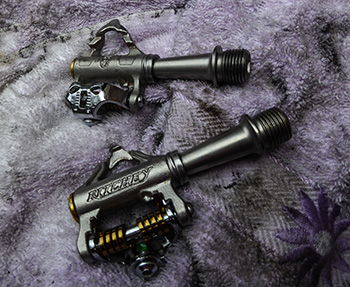
hundreds of years ago (at least, that's how it feels), when the comic was not as it is now and featured several pages of adverts at the rear, adverts that attested to the myriad of components and accessories on which one could spend one's hard-won earnings, i bought two pairs of what were described as sidi podium shoes. these were built like the proverbial brick outhouse; if proof were required, i'm still wearing a pair today for my early morning walks. aside from a perceived need for such footwear (though i confess, podiums -podia? - did not feature in my reasoning), the seller was, in fact, closing down their business and two pairs of the sidis was something of a bargain at the time.
i have never stood upon a podium, so i am somewhat unaware of the requirements attached to such footwear, but i can tell you that the pair currently aiding my morning perambulations could reasonably be described as 'chunky'. and grey. and heavy.
that they bore the word 'podium' in their title would rather suggest heir design was intended to aid the motion of the stage victor while he threw the bouquet amongst the paparazzi and clung onto a cuddly lion while two attractive young ladies smeared their lipstick upon his cheeks. oh, that i should have been so lucky. logical reasoning easily justifies the means, for on the few occasions when i have visited the ancestral home at ardbeg distillery, ascending the metal staircase to the toilets is fraught with danger, especially on the downward part of the trip.
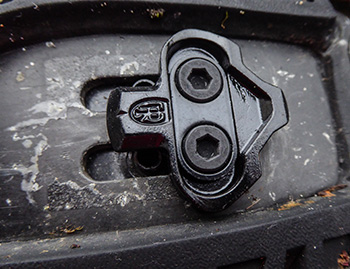
three-point road cleats will do that to a cyclist. though there are a number of differing systems on the market, the majority feature large plastic cleats that exist proud of the invariably carbon sole, enforcing a 'duck-like' quality to the stride of even the hardened roadie and an unenviable ability to skite over smooth flooring. it's perhaps the one time in a roadie's life that they have cause to envy the offroad or cyclo-cross community, provided, as they are, with tiny cleats that sit level with the chunky bits along the edge of their shoes.
granted, there is a certain lack of finesse attaching a pair of crank brothers candy pedals to a colnago or pinarello before clambering aboard in embarrassingly chunky shoes but, as my elderly mother has always been fond of reminding me 'pride bears no pain'. even with that in mind, considering the technological developments that have featured in pretty much every aspect of contemporary velocipedinal life, is it not time that the pelotonese adopted such potentially teensy-weensy pedals and adapted their footwear accordingly?
tom ritchey, a man not noted for his following of tradition without questioning every aspect of it, currently offers a pair of remarkably small micro road pedals, weighing a scant 208 stainless steel grammes, but necessitating a two-point cleat fixing such as that featured on the offroad shoes described above. ritchey's website describes these as 'the perfect gravel bike pedal', countering that mountain bike pedals are generally a tad on the heavy side and offer less cornering clearance. according to the same portion of text, these are tom's favoured pedals.
all that's really missing, to complete the circle, is a pair of carbon soled road shoes with only two fixing points. you do kind of wonder why that is.
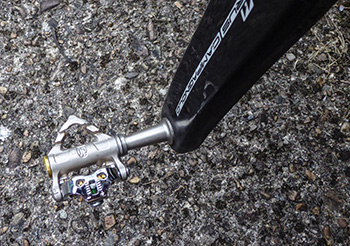
no doubt the offroad community would immediately point out that the pedals are single-sided, potentially adding unnecessary faff when time came to clip-in under mud-confused necessity. but then, these were hardly described as suitable for offroad and those of us with road-going aspirations are not unfamiliar with flipping the pedal in order to clip in. practically speaking, however, the pedals (when new, at least) frequently remain pointing upwards, easing the situation entirely.
the other potential complaint that can be successfully headed off at the pass, is the thought that such tiny pedals with their correspondingly tiny cleats, could possibly offer the same leverage as the standard and much larger three-point cleats. granted, it was not i who crossed the line in first place in innsbruck, so it's perfectly possible that professional riders harbouring far greater power output than yours truly, would laugh heartily at the suggestion that tom's micro pedals could achieve victory in the face of adversity. but then, they have a soigneur on hand with a pair of chunky podium shoes, proffered at the moment of dismountation after yet another impressive victory. you and i, however, have to negotiate the shiny and possibly wet lino floor in debbie's when ordering froth and cake.
i am slightly confused as to why ritchey found it necessary to paint the cleats black, given that even a short trek to the bike shed wore most of it off, a job effectively completed by the pedals after only a solitary ride. still, point of sale is, as point of sale does. having bolted the micro pedals to the carbon campagnolo chorus cranks on my steel ritchey logic, i fitted the cleats to the soles of a pair of giro empire knit offroad shoes. style is, indeed, my middle name.

aside from a slightly annoying squeak from the left pedal/cleat combination (one that i intend to eradicate with a spot of grease), i'm struggling to find any compelling reason to return to the more traditional style road pedal. not only do i not have to walk funny when entering shops or cafés, but on meeting motor cars along any of islay's singletrack roads, i bear no fear over dabbing a foot on wet grass or gravel. the ditches ought surely to remain washingmachinepost free. and while moaning and complaining at the individual who suggested we ascend the north face of the storakaig hill-climb, though my legs may have felt like putty, i'm confident that it is they who are failing in their duty and not the minimal foot contact.
weight-weenies of the world can grin ear to ear, particularly on learning that even ritchey's carbon echelon road pedals would add an extra and surely unacceptable twelve grammes to their lighter-than-air carbon construct (the standard wcs pedals weigh 250 grammes). unless you are under strict enforcement to stick rigidly to carbon-soled road shoes and three allen bolts, you perhaps owe it to yourself to examine the next stage in road pedal technology, all the while wondering if any perspicacious shoe manufacturer might like to give tom ritchey a quick call.
monday 15 october 2018
 ..........................................................................................................................................................................................................
..........................................................................................................................................................................................................i like alf - 14 lessons from the life of alf engers. paul jones mousehold press paperback. 155pp illus. £13.95
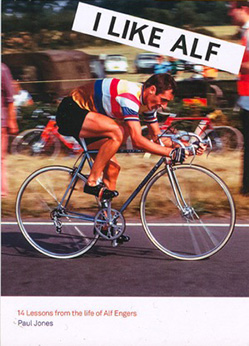
imagine, if you can, a different world infiltrating the great britain of the 1950s and 60s. rather than football being the working man's sport, let's pretend, for a moment, that cycling had imitated the state of affairs prevalent in italy, where a professional life on two wheels was seen as the ideal get out clause from a life of potential drudgery, tilling soil and working on the land. instead of roy race's exploits with melchester rovers, readers of the 'tiger' weekly comic might have been regaled with deeds of derring do in the quest for best british all rounder time-trialling.
in which case, it would scarcely have been a fictitious chap by the name of roy; more likely a real fellow by the name of alf.
born in southgate on the 1st of june 1940, alf engers grew up to be a pastry cook, working nights while pursuing a career as a cyclist, having acquired his first bicycle at the age of ten. though sharing a christian name with his father, the two weren't exactly close. "He was very keen on fishing. Didn't have any time for me. Worked my mother to death. That's it."
this state of affairs contrasted sharply with memories of his mother: "(She) was very hard-working and brought up in the Depression. In other words, she knew what poverty was. [...] Mother helped me in any way she could; she had a will of iron."
engers pursued both swimming and running while at school and occasionally accompanied his father when he went fishing. however, after the blitz and its destruction of large areas of london, engers joined in the cycle speedway craze of the time 'amongst the brick and cinders', indulging in lethal laps of tiny oval circuits on beat-up bicyles largely devoid of brakes. "I was 14. Cycle Speedway (was) good for girls and I went out with one of the other bloke's sisters. [...] There were loads of these bomb-sites." According to sports historian, Simon Inglis, one of the driving reasons behind this wholesale adoption of a hitherto unrecognised sport was "...the birth of a youth culture that hadn't existed before, which enabled kids to have a completely separate identity to their parents for the first time - cycle speedway was something that no adult did."
with an honours degree in hindsight, it's easily possible to view this early adoption of teenage culture as one which may have shaped engers' subsequent brushes with the authorities that constrained british cycling practice. he was not one to subsume his aspirations to the whims of authority for which he often held little respect.
Lesson three from jones' superb narrative (all 14 chapters, perhaps obviously, given the book's subtitle, are prefaced with the word 'lesson') introduces the reader to the formative and formal steps in the teenage engers' cycling career when he joined barnet cc and was inducted into the mores of club cycling. membership of the barnet introduced him to club runs along with evening ten and 25 mile time-trials. oddly, considering his later prowess as one of britain's premier tt riders, the discipline against the clock was not one of his initial interests, holding riders such as fausto coppi in high esteem and cycling to leicester square to purchase copies of 'le miroir des sports', contributing to his collection of cycling magazines.
"Time-trialling didn't interest me, I wanted to be a road man, or a track man."
despite this alleged preference, engers began competing in 25 mile time-trials, inspired by the higginson twins. "...they used to ride in a dead straight line, no messing, straight corners. They became my heroes. [...] They used to take the ball bearings out of their wheels and bottom brackets and polish them." but, though from a different sporting discipline, throughout the 1950s, alf's true hero was sir roger bannister, the first man to run the four minute mile, though he gained more specific time-trialling inspiration from the performances of the inestimable ray booty as he edged ever closer to riding 100 miles in under four hours in the mid 1950s.
in 1954, however, alf's promising career was rudely interrupted by a crash while returning from an evening ten. the accident totally shattered his kneecap, enforcing six weeks in hospital and ultimately a year out of competition. returning from this mishap, engers was aided and abetted by alan shorter, one of the senior members of the barnet club. engers attributes much of his future success to the guidance proffered by shorter. "I remember somebody saying to him 'You're a has been'. Old Al replied, 'Better to be a has-been than a never-was or never-going-to-be."
though engers still had his sights set on becoming a professional cyclist on the continent, a rider who one day might win the tour de france, it was a career that was simply not to be. having been brought up during the second world war and its immediate aftermath, he was conditioned to be a provider, hence his continued employment as a baker, sometimes for as many as three different bakeries at the one time. with british cycling authoritarianism enforcing strict delineation between the beloved 'amateur' and the questionable 'professional' class, alf saw the only way forward being to adopt the intermediate 'independent' status. this allowed the intrepid cyclist to 'try' riding outside the restrictions of the amateur, to test the waters, so to speak, of a possible professional career. riding as an independent technically allowed the incumbent to re-apply for amateur status should things not work out as planned.
however, having discovered that racing as an independent did not bring the fame and fortune tentatively promised, engers applied to return as an amateur, providing a lengthy period in no-man's land, unable to compete for several years up until 1968, despite the independent category being abandoned in 1966. it was to be the first of many of engers' brushes with the blazers who controlled the lives of britain's cyclists. in the meantime, alf went fishing.
engers went on to win the national 25 mile time-trial six times and to become one of the foremost exponents of drillium, the practice of drilling holes in any and every component that would survive the process, all done to remove as much weight from the bike as possible.
"If I had gone on to do what I wanted to do, I would have won the Tour de France, but that's how the dice were rolled."
paul jones, author of the previously reviewed mousehold press publication 'a corinthian endeavour' proved with that particular book that, beyond any doubt, he is possessed of inherent skills as a wordsmith. i like alf (the title is derived from frame stickers attesting support of engers in his battle with the authorities) ranks alongside many of the other superb publications to come from adrian bell's mousehold press. the latter has proved to possess an uncanny knack of publishing cycling books that have changed the face of the genre. classics such as herbie sykes 'the eagle of the canavese', jean bobet's 'tomorrow we ride' and graeme fife's exemplary biography of brian robinson, have now been joined by this essential publication.
the prose is intelligent, the narrative addictive and the author's prescience in framing the life of one of british cycling's great characters commends it to every individual who considers themselves a connoisseur or apprentice connoisseur of the sport. time-trialling and, indeed, pretty much all forms of road and track racing, have substantially changed since the time of alf engers. whether this is seen as a good thing or otherwise, probably depends a great deal on your age and nostalgic reverence, but as someone far wiser than yours truly once said, 'in order to comprehend the present, one must first understand the past.' buy one for yourself and a second copy as a christmas present for your best pal in the peloton.
lessons learned.
sunday 14 october 2018
 ..........................................................................................................................................................................................................
..........................................................................................................................................................................................................adoption agency

one of the main roads from glasgow to kintyre and ultimately the southern hebrides, is the a83, a two-lane road on which the brilliantly named rest and be thankful climb is placed between arrochar and inveraray. the original single track road, which not only still exists, but was recently and expensively re-surfaced, sits several hundred metres below the modern version. unlike the latter, the old road, generally referred to as the 'military road', reflecting upon its original purpose in life, is flat along most of its length, before rising steeply over the last portion. modernity has demanded a more gradual ascent to appease the contemporary motorist. unfortunately, despite its strategic placement as the road to the isles, the a83 suffers from frequent landslides over the winter months, often rendering it impassable.
such a situation exists even as you read these pixels. on wednesday of this past week, 2,500 tonnes of mud and rocks slid down the adjacent, steep hillside, creating the need for a 60 mile, 90 minute diversion for all traffic heading to islay and kintyre. apparently at one time the lower slopes were home to a forest of trees, the felling of which has created the current and omnipresent difficulties. mrs washingmachinepost and i first travelled to islay in the early 1980s and work was underway at that point to mitigate the effects of these landslides, work that continues, albeit with limited success, to this day. even the resurfacing of the military road below, was undertaken to allow its use in such an emergency; vehicles would be allowed through in convoys, waiting impatiently until the opposite direction had cleared before continuing on their merry way.
unfortunately, though there are hi-tensile, hi-tech nets placed above the 'new' road in the areas most at risk from mud-slides, the latest infractions have not only made their way through the nets before traversing the a83, but carried on towards the military road below, rendering pretty much every contingency null and void. thus, at the time of writing, the road remains closed to motor traffic. there's little denying, however, that it would be great fun (and passable) on a 'cross, gravel or mountain bike.
i am most certainly not a roads or transport engineer. i know little or nothing about matters such as that discussed above. however, purely on the basis of having watched many editions of the giro d'italia and tour de france, i cannot help thinking there's an obvious solution to this recurring and long-standing problem. i believe the device of which i'm thinking, is referred to as a 'snow shed', an open-ended, concrete construction that covers the roadway like a tunnel, featuring a sloping top that would have the mud and rocks slide harmlessly over the roof and down the other side.
i've no doubt that the construction of such structures would not be cheap, but i seriously doubt the price would be any greater than the amounts spent over the last thirty-something years to achieve, apparently, nothing at all. however, if this seems so glaringly obvious to me, i can't help thinking there has to be a fundamental flaw in my thinking. either that, or it really is so glaringly obvious that it'll simply never happen.
which brings us neatly onto the subject of tyre inflation and punctures. to ease you into the rather obvious difference between cycling rubber and mudslide-blocked roads, let me once again take tautology to the outer limits of its definition. whether using tubeless, inner-tubes or tubulars, the integrity of your rolling stock, so to speak, relies almost entirely on keeping those parcels of fresh air intact. any egress of air is bound to have a negative effect on the forward motion of your bicycle. the obvious solution, therefore, is to either build an impregnable defence around that parcel of air, or dispense with the latter altogether.
arguably the highest profile proselytiser of the solid tyre is tannus, a company offering a wide range to suit most styles of cycling. yet, despite those tyres offering a high degree of impregnability, the idea hasn't really coaught on in the numbers you'd perhaps tend to expect. last weekend, i rode with a fellow who regularly features tubulars on his wheels, something usually only seen on the bikes of the professionals. meanwhile, the bicycle tyre industry is more intent on selling us tubeless tyres in preference to the tried and tested clincher plus inner-tube. to the best of my knowledge, none of the major tyre purveyors feature solid tyres in their road or mountain bike range.
i do understand that there are inherent limitations to the solid tyre, particularly when applied to the sporting milieu, but in this age of endless technological research and development, i seriously doubt that these limitations could not be overcome. the prospect of riding without any fear of puncturing is surely one that the majority of us would welcome, yet few of us have adopted.
is this another case of the solution being so glaringly obvious that it will never actually happen?
saturday 13 october 2018
 ..........................................................................................................................................................................................................
..........................................................................................................................................................................................................a cycling year

those of you who suffer from insomnia will probably have investigated each and every piece of thewashingmachinepost in the search for drudgery that will save you from endless hours in an awakened state. and at some point in those investigations, you will likely have happened upon the section entitled 'cycling on islay'. for the benefit of those who have no difficulty reaching an equitable state of slumber, let me inform you that this postal division leads the cycling visitor from arrival at the ferry terminal along many of the highways and byeways they might discover from the saddle.
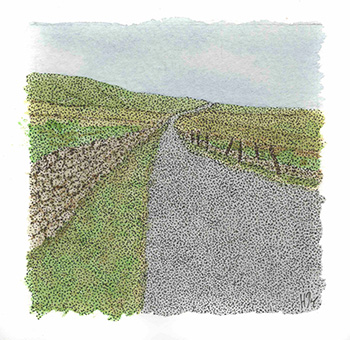
sadly, despite the advent of multimedia, 'cycling on islay' remains purely a text-based narrative, despite my best intentions to populate those paragraphs with imagery relating to that which might be seen during the aforementioned perambulations. an editor with whom i once had the pleasure of working, always maintained that a picture was indeed, worth at least a thousand words. he's probably turning in his grave at this very minute as i reluctantly mention my still picture-less travelogue.
but the lack of imagery extends further than this. despite having made endless reference to the ubiquitous sunday morning bike rides, it would be a rare moment indeed were i to furnish you with photo opportunities from these weekly events. i cannot deny that many of my reviews have been accompanied by images featuring the hebridean nooks and crannies of my surroundings, but those are predominantly 'accidental' rather than deliberate enticements of a vacational nature. and as a gent with a formal art education background, you would be forgiven for expecting the occasional artist's impression every now and again.
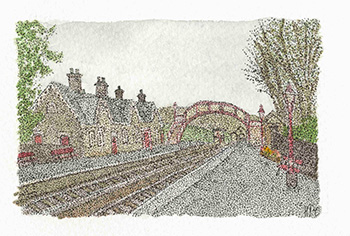
but, in truth, i can scarcely recall specific moments pertaining to those outings on the sabbath, moments upon which i might reflect as i valiantly attempt to stifle a yawn and drooping of the eyelids on a sunday afternoon after a fulsome repast at lunchtime. thankfully, for man and woman kind, to say nothing of cycling kind, heather dawe follows not in my cycle tracks. ms dawe has featured previously in these black and yellow pixels by way of my review of her 2013 publication 'a bicycle ride in yorkshire'.
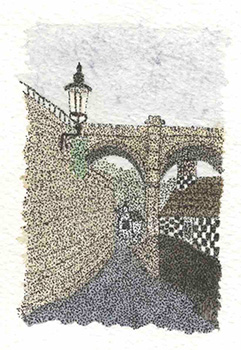
still enjoying her cycling round the yorkshire countryside, heather is intent on producing an accompanying volume entitled 'a cycling year' in which she has been inspired by a 1938 bartholomews cloth map of wharfedale discovered in the back of an old book purchased from a local flea market. for good measure, she'll be including a printed version of the map within the covers of this latest volume. and similar to her previous book, she's looking to kickstarter to help raise the finance to bring the project to a successful fruition.
'a cycling year' continues the flavour of its predecessor and i asked heather whether my description of her paintings as pointillist is one in which she finds a natural form of expression, or is it a more cultivated style?
"The style is pointillist and one that is a natural form of expression rather than anything taught. I don't know if anyone would have the patience to teach it! When I think back now, I used to paint and draw in this kind of style when I was at school. Then I left school, studied maths at university, raced bikes and worked in data analytics for the best part of 20 years before coming back to painting (and writing) around seven years ago. I still work in data analytics, race bikes less (I have a young family) and squeeze in the painting and writing when I can which is normally in the early hours of the morning."
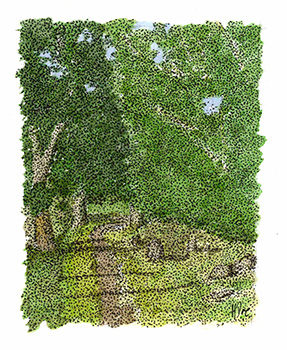
by its very implication, cycling round yorkshire, scene of next year's world road championships, consists of illustrations of the surrounding landscape. so in view of the latest book featuring these uniquely-styled illustrations, does heather find this a style well-suited to depicting this particular subject matter?
"I have never really thought about that. I am just inspired to paint by the things I see when I am out cycling and running. I love painting back home in the weeks after a bike ride or a run; all the memories and colours come flooding back. This style is one I seem to be fixed with and enjoy being able to build up the volume of a scene with dots after initially painting it."
aside from my continually informing all and sundry that cycling cures all ills, it's hard for many of us to think beyond the next bike ride. because, at the risk of being called obsessive, riding a bicycle anywhere in the countryside (yorkshire, the hebrides, whatever...) is a joy in and of itself, something with which it's possible to punctuate daily life, leaving the rider refreshed and ready for the next challenge between bike rides. but for heather, was the detailing and recording of a year's worth of cycling something of a catharsis, or does her book contain a more outward-looking narrative?

"The book's illustrations reflect scenes from the rides. The writing is more 'travelogue' in style; I write about the cycle rides themselves, artists and writers who have been inspired by cycling and/or the Yorkshire landscape (and how they have inspired me),the history of the landscape and the things I see and think about along the way."
content such as that described by heather, promises to act as an enticement to the reader to experience yorkshire in person, using the book as either a tentative guide, or as the forerunner or memento of 'the real thing'. as can be seen from the accompanying illustrations, her images feature delightfully calming properties, the sort of pictures to which the reader/viewer can return time and time again. that tends to suggest that the artist has a particular affinity with the subject matter, allied to a deliberation over their creation. on average, how long does each take to produce and what media does she make use of?
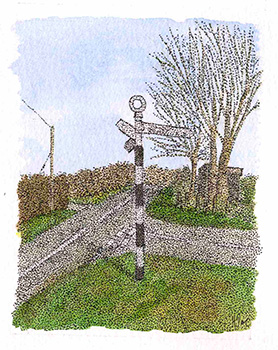
"Each illustration takes three-nine hours, depending on how elaborate it is (basically how many dots are required). on average, five hours (probably). They're all created with watercolour and ink."
in 1998, a friend and i took a ferry to ireland before cycling south, over a couple of days, to witness the start of 'that' tour de france, eventully won by marco pantani. aside from the prologue time-trial and the first 'proper' stage to occupy our attention, there were a number of 'side-shows' in dublin to fill in the gaps between cycle racing. one of these 'distractions' consisted of a photographic exhibition, presenting framed images of our road heroes past and present. with yorkshire ready and waiting to host the 2019 world road-racing championships, surely that presents the ideal opportunity for heather to promote her artwork to that of a bona-fide exhibtion.
"That is something I would dearly love to do. I have no plans as yet, but i'd be keen to hear from anyone who may be interested in exhibiting them."
since we're all modern people heareabouts (some more than others), i think it unlikely that i have to explain what happens next. the kickstarter link appears below, in close proximity to your computer's cursor; one click is all it takes.
a cycling year by heather dawe | all images © heather dawe 2018

friday 12 october 2018
 ..........................................................................................................................................................................................................
..........................................................................................................................................................................................................what is it good for?

many years ago, when on the lookout for a new bass drum pedal, a special offer on a double-pedal for a few pounds more than the single version caught my eye and my credit card duly took advantage. for those less than well-informed as to the mechanics of modern-day drumset playing, on the drummer's side of the bass drum (the big one with the band's name on it), is an attached pedal, allowing the intrepid percussionist the opportunity to make a great deal of noise every few beats or so. drummers such as ginger baker, louie bellson and alex van halen have often employed a second bass drum, allowing the luxury of a substantially voiced ostinato (repeating pattern) while flailing ostentatiously during a drum solo.
the above mentioned and their ilk sported a pedal attached to each drum, but carting and setting up two large bass drums is, i'm sure you'd agree, a level of faff that probably gets tired very quickly. thus was invented the double-pedal an arrangement that features two beaters lined up on a single bass drum, with the left pedal (assuming the drummer to be a righty) connected by means of a rotating rod. it is then a simple matter of moving that left foot from its usual position on the hi-hat footboard, onto the left bass pedal and partying like it's 1999.
so far, so simple, except that it's not. i cannot deny that, in all the years i owned this double-pedal, i was never once provided with material that required its use. yes, i did occasionally attempt to make a pleasing racket during those long, drawn out endings that are frequently included in raucous blues songs, but rarely did the resulting sound manifest itself the way it had sounded in my head.
approaching the problem in a logical manner, if it had proved possible to percuss smoothly and effectively in the hand department after diligent practice, then it was more than likely that similar scrutiny could be brought to bear in the foot department. thus, those two beaters were suitably aligned on a floor-mounted pad and paradiddles, ratamacues, single and double-strokes were repetitively practiced, very much to the irritation of mrs washingmachinepost downstairs. disappointingly, progress came at a snail's pace. in the absence of any desperate need to actually include such foot patterns in any musical activity in which i was involved, the pedals were eventually sold in favour of a more lightweight and solitary footplate.
however, while enthusiasm had still got the better of me, i had researched far and wide to figure out why it was my feet had acquired nowhere near the speed and dexterity of someone like thomas lang. heck, i was even using the same make and model of double-pedal, for goodness sake. during my period of investigation, i came across an article which suggested that cycling was an ideal activity that might lead to winged feet. what a coincidence that i was already familar with such practice; it was surely only a matter of learning to articulate the ankles like marco pantani and a world reunion tour with cream was but a few steps away.
but either i wasn't doing it right, or the author of said article was more optimistic than yours truly. my double-pedal technique scarcely improved at all.
during yesterday's world mental health day there were many postings on twitter alleging that cycling was an excellent antidote to depression or negative feelings. it's a contention with which i'd spuriously tend to agree, though as one who has nary come into personal contact with depression, i have no practical experience of which to speak. but as rapha's ultan coyle has been quoted as saying "nothing's ever worse after a bike ride". and it transpires that bike-riding offers other benefits too, one of which might translate to the pennies in your pocket.
according to specialist broker carinsurance4cyclists.com, there is a tangible link between road cycling and a clean driving record, for which they are happy to offer significant savings to the pedallists. ci4c claim to have annual data relating to car drivers from the cycling community (club members and triathletes) demonstrating that they have less than half the number of accidents when compared to non-cyclists.
the data apparently demonstrates that, while the average claim rate is 13 drivers in every hundred, those insured with ci4c, (all cyclists by definition) have reduced that to only six.
"Our proposition was always that an enthusiast's on-road cycling experience should make them more alert and road aware. As a vulnerable road user, cycling certainly trains you to be more alert to the dangers of road use and better able to anticipate hazards. You're more aware of how you fit into your surroundings and you'll ride, or drive, accordingly. Physical exercise plays a part too. It leads to improved mental agility and we maintained that this would make you a more responsive driver."
far be it from me to translate the above into an advert for a car insurance broker, thus entailing that my reader participate in something as foreign as driving, but the number 22%, has been bandied about as an average saving, should he/she decide to turn to the dark side. meanwhile, thomas lang need not lose sleep that i am poised to take his double-pedal crown in the foreseeable future.
carinsurance4cyclists | thomas lang
thursday 11 october 2018
 ..........................................................................................................................................................................................................
..........................................................................................................................................................................................................communication breakdown

according to my profile on twitter, i've been posting smartass one-liners for almost ten years, something of an unfortunate admission, given my lack of enthusiasm for social media. it's possible that i am not alone in my lack of enthusiasm, considering that the number of folks following me on twitter has scarcely moved upwards for several years. however, i figure there are only so many idiotic remarks that one can appreciate in any given period of time.
i first signed up for twitter as a result of reading an article in the bicycle trade's bible, 'bike biz', one that encouraged those in the bicycle industry (where i am arrogant enough to think i have at least tentative membership) to investigate these new digital horizons. though i figured it likely that those who actually trade stuff for a living might conceivably benefit more tangibly than i, there didn't seem any harm in putting a toe in the water. those first few months were purely exploratory, attempting to find out quite what the point of 'micro-blogging might possibly be. along with many others, i'm still trying to work that one out.
strangely, that's another factor of social media in which i believe i'm not alone. the folks at chris king in west nela street, portland, persuaded me to join instagram, but, devoid of a necessary mobile phone, that was never really going to work. for starters, i failed to see why anyone else would have any interest whatsoever in badly framed photographs of obscure corners of the island, even those featuring even more obscure corners of bicycles. i do have an ipod touch, a device that allows the snapping of images such as those previously described, but it is bereft of mobile access to allow their immediate uploading.
by the time i returned home, i'd forgotten all about them.
i could find no enthusiasm for flickr's ablity to store and organise my photos; who could truly be bothered uploading a myriad of bicycle pictures in the days before fibre broadband, and once again, why would anyone care? i wouldn't touch facebook with the metaphorical barge-pole and at the risk of laying bare my distinct lack of cool, i really have no idea what snapchat is. nor, indeed, do i really care.
that said, while any one of the above could conceivably offer hours of malcontent, none should be seriously considered as either an alternative or adjunct to a bicycle ride. as i sit in the croft, typing almost dyslexically at my laptop, but a matter of centimetres to my left is a telephone. when i have vacated my abode in favour of the office on five days of the week, the same situation applies to my desk, only the telephone sits to my right. when i finally plonk bum on saddle and reach escape velocity, to be perfectly blunt, i really don't want anyone to call me, hence the happy lack of a mobile phone.
as with many features of modern life, once again i find myself in solitary, for you will find, with almost every other member of the sunday peloton, that they have a mobile device ensconced in one of those three rear pockets. one or two will insist that this is purely in the interests of not missing a photo opportunity, completely ignoring the salient fact that it's a phone. this, despite the marketeers placing far greater emphasis on the snapping of pixels, as opposed to the clarity of speech transmission. even the mighty dave t has a phone in his back pocket.
you may well wonder what the world is coming to.
but whatever accusations i might surreptitiously level at my fellow pelotonese, i can honestly state that never once have i seen any of them retrieve their amply screened devices mid-ride and chat vicariously while following the wheel ahead. (though there was a fellow in the londres-paris peloton last year seen feverishly texting as we rolled onto the cobbles of the champs elysées) for that would surely make us no better than our four-wheeled, ever-so-slightly-faster cousins. it's a view with which the dutch government apparently agrees, having recently framed legislation banning the use of mobile phones as of next july.
according to the country's transport minister, introduction of such a law will make it an offence "to hold a mobile, electronic device while driving all vehicles. on pain of a €230 (£205) fine. "This decision sets a clear standard: if you drive a vehicle in traffic, whatever the vehicle, you do not need to hold a mobile electronic device." granted, i know of no cyclists who would find this an arguable stance. there may be less information displayed on a bicycle's handlebars than in the immediate surrounds of the modern motor car, but when cycling in traffic, let's be honest, we need as few distractions as possible.
though i have squirmed through squinted eyes on meeting a tractor driver who insists on waving with one hand, while holding a phone in the other, according to the dutch, one in three 12 to 21 year-olds are guilty of using their phones while cycling and phones reportedly featured in around 20% of bicycle accidents involving the under 25s. there are, of course, many tracking features available to the cyclist that depend on there being a mobile device somewhere about their person, but rarely does that require the individual to spend any time paying close attention to a hi-res touchscreen.
at the risk of sounding like your mother, if you really have to make or take a call, stop at the side of the road. lets not make for any avoidable reductions in the international peloton.
wednesday 10 october 2018
 ..........................................................................................................................................................................................................
..........................................................................................................................................................................................................dry cleaning

saturday's bike ride was more than pleasant, predominantly due to frequent bursts of sunny weather and blue skies. though i'd hesitate to say it was also cosy and warm, it was certainly one of those days when a long-sleeve jacket was perceived as necessary augmentation, but occasionally an accessory that proved a tad on the warm side. with photographs to be taken for future reviews, when removing the jacket to feature the short-sleeve jersey and armwarmers concealed beneath, i must admit to feeling a chill or two. mind you, when a smattering of showers arrived, i was more than glad of that jacket.
it is, however, the west coast of scotland and, to be more specific, the southern hebrides, so sun, sea and sand rarely hang about for too long, a fact that was heavily underlined on arising for the sunday ride. though it was only just possible to view land across the loch, it may help set the scene, if i tell you that calmac cancelled the majority of the day's ferries. the velo club are, if nothing else, undeniably idiotic in the face of adverse weather conditions, joined as we were by a stalwart of a fellow from washington dc (thank you josh) for a curtailed perambulation of loch gorm. that's just the way we roll.
and while i'm here, it seems only fair that i offer a public apology to aileen for turning the café floor into a swimming pool during the post-ride froth-supping.
persistent to the end, the galeforce winds and horizontal rain, joined by altogether chilly temperatures, were still hindering progress by the time i arrived home for a warm shower. though i have reiterated at length the degree of fastidiousness normally applied to my eleven-speed chain, such ministrations are for a time and a place. this was neither. therefore, the ritchey was stowed in the bike shed with scarcely a thought for ceremony, meaning neither bicycle nor chain were fettled with the fervour that you would hope would be the case.
the downside to this state of affairs, and i can do little other than admit my culpability, is that by the time next week's cycling nirvana arrives (a nirvana that currently promises more gales), there's more than an evens chance that my once shiny chain will feature spots of ferrous oxide, despite liberal prior application of a recommended lubricant. the negative effects of the localised salt, sea air have been well-documented in these very pixels on many a prior occasion, but there is little in the way of avoiding such pervasive atmospheric conditions. let's not kid ourselves; this stuff affects everything within earshot.
it therefore comes as something of an unexpected surprise to discover that a well-known purveyor of bicycle cleaning and lubrication products has introduced a range specifically designed for e-bikes. i'm well-aware that electrical connections are perhaps more susceptible to the conditions described above, than 'regular' gear cables and the like, but chains? their latest waterless wash and dry chain cleaner, may well be designed to allow an e-bike to be cleaned and fettled without water, but is this not a revelation that should have been previously available to those with analogue bicycles? after all, to the best of my knowledge, the chain on an e-bike is exactly the same as those featured on the stuff we all ride.
and the same could surely be said about anti-corrosion protection, particularly in the light of the wi-fli, di2 and eps gear systems that havae been prevalent for more than a few years. the selfsame brand's product is designed to drive out moisture and leave a protective, anti-corrosive layer on the frame. in that respect, how is the average e-bike any different than the collection sitting in the bike shed? lubes are also available to withstand the alleged higher torque loads that batteries apply to a bicycle chain. am i coming across as rather cynical?
good.
tuesday 9 october 2018
 ..........................................................................................................................................................................................................
..........................................................................................................................................................................................................